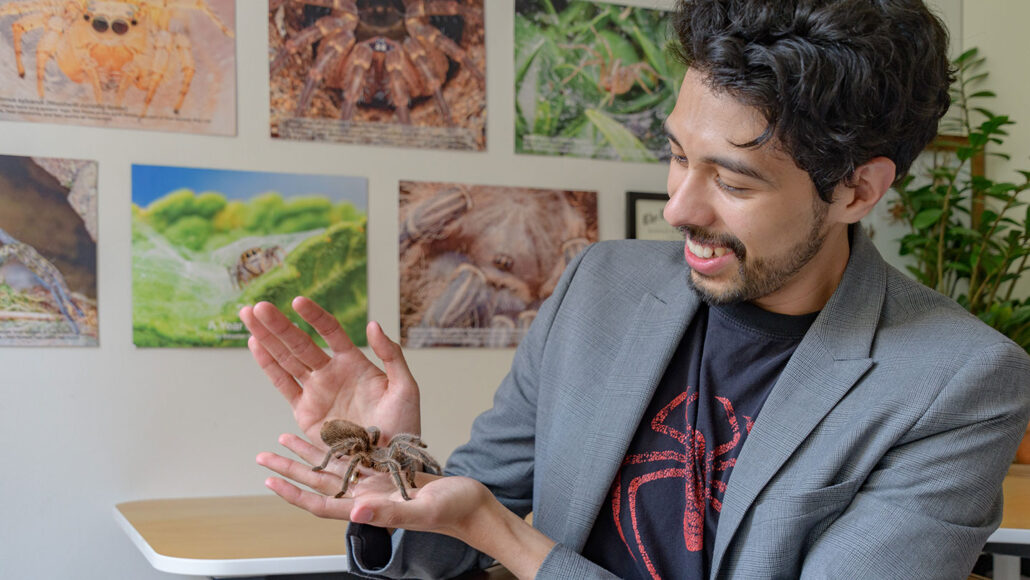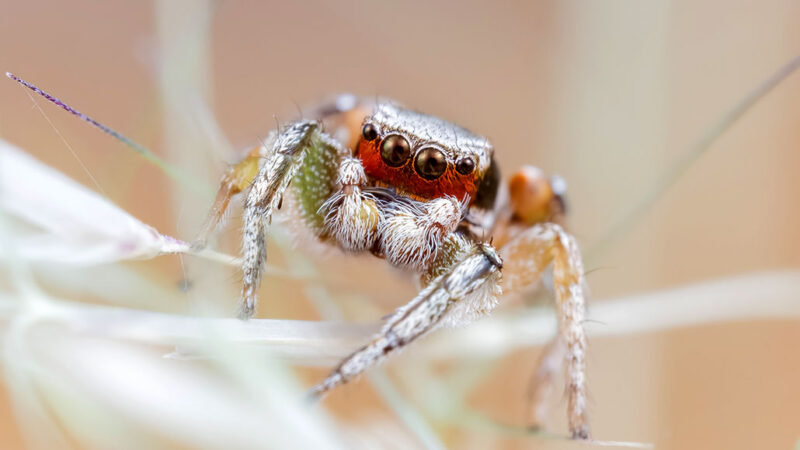Dancing spiders inspired this biologist to teach others
After studying animal communication, Sebastian Echeverri helps others appreciate arachnids

As a Ph.D. student, Sebastian Echeverri taught people about spiders at his local museum. Helping others learn about these misunderstood — and often feared — animals inspired him to pursue a career in science communication. “The more I did it,” he says, “the more I realized that this is what I really love.”
S. A. ECHEVERRI
Sebastian Echeverri always had a passion for animals. Studying spiders, though, wasn’t originally part of the plan. That changed when a professor showed him a close-up video of the fiery-haired paradise jumping spider. Regular fashionistas, the males of this species sport a bright red face and green legs. They also “sing” through the ground using vibrations as part of a choreographed dance. The males move their colorful legs along with these vibrations to woo females.
“The moment that I first saw this dance was when I got hooked on spiders,” says Echeverri.
Echeverri went on to study these grooving arachnids as part of his research on sensory ecology. That’s the study of how animals interact with their environments and each other using their senses. While he enjoyed his work, Echeverri struggled with undiagnosed autism and ADHD (attention deficit hyperactivity disorder). He also felt that academia failed to support students from diverse backgrounds. “And [those issues] made it hard for me to do the fun science that I loved,” says Echeverri.
Inspired by his research in animal communication, Echeverri began exploring ways to teach others about science. Today, he shares his passion for spiders as a science communicator. In this interview, Echeverri shares his experiences and advice with Science News Explores. (This interview has been edited for content and readability.)
What inspired you to pursue your career?
My earliest inspirations were from television. I remember watching a lot of wildlife documentaries. The sense of discovery and wonder at all these strange creatures out there was really captivating.
How did you get to where you are today?
In addition to my research, I started volunteering at the local museum. I would bring out some spiders and talk to people. That’s not easy because they might have heard a lot of negative things about spiders or be scared to approach them. The more I did it, the more I realized that this is what I really love.
I loved doing research as well. But there were a lot of issues with academia that were really frustrating, and I didn’t feel supported. As a kid, I do not recall any TV shows where I saw someone that looked like me or that had a similar background. The expert would often be a very traditional academic: an older white man doing an interview in a suit. When I was doing science education, though, I felt like I could give that support to new learners.
How do you get your best ideas?
This is something that I’m still learning how to do. I only started to understand how my brain works. I spent the first 30 years of my life not knowing that I am autistic and have ADHD. And simply feeling that I was really bad at everything that everyone else could do very easily.
I’m still learning new strategies and unlearning old strategies. I spent most of my life trying to get past my ADHD by procrastinating and feeling terrible the entire time. That was really difficult for me and almost made me choose to leave my Ph.D. and change what I was going to do.
Now, I’m feeling a lot better. I’ve gone to therapy and am taking ADHD medication, which helps a lot. If I’m trying to come up with a new idea for something, I’ll just brainstorm with no expectations. I’ll sit down with a blank piece of paper and write down what comes to mind with no intent to make it legible or good in any way. Then I’ll put that down for a while and do something else. When I let it sit, I can come back and reassess.
What is your biggest success?
I grew up watching nature documentaries, including those on the BBC. I never thought that I could make one of those. In 2021, I got an email asking if I’d be interested in applying to be the co-host of the BBC Earth podcast. I thought that email was spam when I first read it because I had not reached out.
The next year, I co-hosted and produced a wildlife podcast series with the BBC Earth team. It had all of these cool stories about people connecting with animals. My co-host and I had a huge part in how it sounded. We got to steer the show into places that we were curious and fascinated about. We also worked with a really awesome team of audio engineers and reporters who helped put that all together into something that sounded really cool. There’s something special about getting to do what I would watch and listen to as a kid.

What’s one of your biggest failures and how did you get past that?
There was a point in my Ph.D. program where I had to switch labs. I didn’t know whether I could continue researching jumping spiders. One of the big focuses of the new lab were these tiny, colorful frogs called poison dart frogs. My professor and I came up with this idea of studying the color vision of the tadpoles and how it changes as they become adults. Some of them come in a lot of different colors, even though they’re the same species. And as babies, it seems they learn what color their mom is. And they remember that when they’re adults to make decisions about how they interact with other adult frogs.
I tried to measure the color vision of these frogs. I’d spend weeks at a lab dissecting frog eyes and trying to shine a tiny laser beam at one cell inside of an eye. I had to dissect and measure them in the dark. I spent so long trying to get any sort of useful data. And it just completely did not work.
At some point, we sent some of the frogs to someone who had a lot of experience with the machine. They were able to just toss them in and get the data. Clearly, I did something wrong. It was disheartening at the time. I didn’t know how I was going to finish enough research to complete my thesis. But throughout all of it, my advisor was so supportive. She said sometimes these things go wrong and that we would figure out a way to complete my dissertation. And we did. I was actually very happy with what I ended up doing.
What piece of advice do you wish you’d been given when you were younger?
Right now, we have an amazing opportunity to connect with scientists and educators as people. I wish that when I was a kid, I had been able to see the diversity of people in this field and the different ways that people have explored careers in science. I would say, go look into and follow scientists that are doing the work you’re interested in. You get to see that they’re just people like you and me with all the same flaws and abilities. But you’ll also get exposed to a lot of possibilities that you might not see in other cases.







